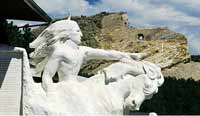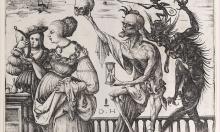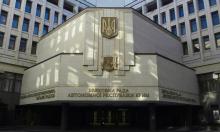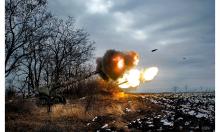Crazy Horse still not ready
The Crazy Horse monument - the largest mountain carving in the world - is still not ready 60 years after the works on the monument began.

The carved face of Crazy Horse has been completed and a welcome center and museum are open, but the carving of the Lakota warrior's his body, his horse, and a planned university and medical training center for American Indian students are still years away.
Ruth Ziolkowski, widow of sculptor Korczak Ziolkowski, who started the memorial on June 3, 1948, won't predict when it will be done.
"To picture it 60 years from now, I'd like to think we had the first building, at least, for the university so that we'd actually have some students here," she said.
"I'd like to see the museum enlarged and over at the foot of the mountain where it needs to be. I'd like to see the horse's head finished and polishing Crazy Horse's body and doing all of the finish work on it."
Ziolkowski took over the project when her husband died in 1982 and shifted the focus to Crazy Horse's face, which was dedicated 10 years ago at the 50th anniversary and has helped draw more attention to the project.
The invitation to undertake the carving came from Lakota Chief Henry Standing Bear, who was prompted by Gutzon Borglum's carving of nearby Mount Rushmore to seek a memorial for Indian heroes.
Crazy Horse was a famed Lakota warrior and leader who played a key role in the 1876 defeat of the U.S. Seventh Cavalry at the Battle of the Little Bighorn in Montana. He died a year later after being stabbed in Nebraska.
"What Mount Rushmore represents to Americans is what Crazy Horse represents to American Indians," said Robert Cook, a cultural specialist at the memorial and president-elect of the National Indian Education Association.
"Crazy Horse represents the values of American Indian tribes - of bravery, respect generosity, wisdom. So by being on this memorial he represents some of those struggles that he fought for a long time ago, of protecting our land base and our treaties. We're still in those fights today."
Seven of the Ziolkowski's 10 children and several grandchildren work at the memorial, which draws more than a million visitors to the southern Black Hills annually. It brings in millions of dollars every year, mainly through admission fees. The family has held to Korczak's admonition to refuse government help and instead rely on private enterprise.
The foundation started its first national fund drive in 2006 to raise more than $26 million (EUR 16.77 million) toward the mountain carving's completion and expand cultural and educational programs at the memorial. In December, billionaire T. Denny Sanford, a Sioux Falls banker, pledged a $5 million (EUR 3.22 million) matching grant, the largest ever. And in April, the memorial's scholarship fund topped $1 million (EUR 640,000) in contributions to native students.
To prepare for the first explosion in 1948, Korczak Ziolkowski used hand tools to drill the holes. Now, a team of workers uses high-tech, expensive equipment to create the larger-than-life art work.
Rich Barry, one of the engineers, said that just as the project has evolved over 60 years, so have the challenges.
"Imagine starting back in 1948 going up there with a hand drill and a hammer and starting to blast away on the mountain and finding anybody believing that you're going to even do it," he said.
"Now all of a sudden people have really come around. It's very rare that someone says, 'Aw, it's never going to happen."'
Now the biggest challenges lie in figuring out how to carve the other parts of the sculpture in relation to the face and contending with the natural fractures in the rock - especially on the outstretched arm, Barry said.
"We will do much like orthopedic surgeons do. We'll pin blocks together to hold them together to meet the artistic intent," he said.
Two blasts on the mountain will mark Tuesday's 60th anniversary. The first will duplicate the initial 10 tons of rock blasted from the carving on June 3, 1948, and the second will be larger.
"We're going to recreate that blast and also do one typical of the size we do now so that you can see the 'then' and the 'now,"' Ruth Ziolkowski said.
Subscribe to Pravda.Ru Telegram channel, Facebook, RSS!





